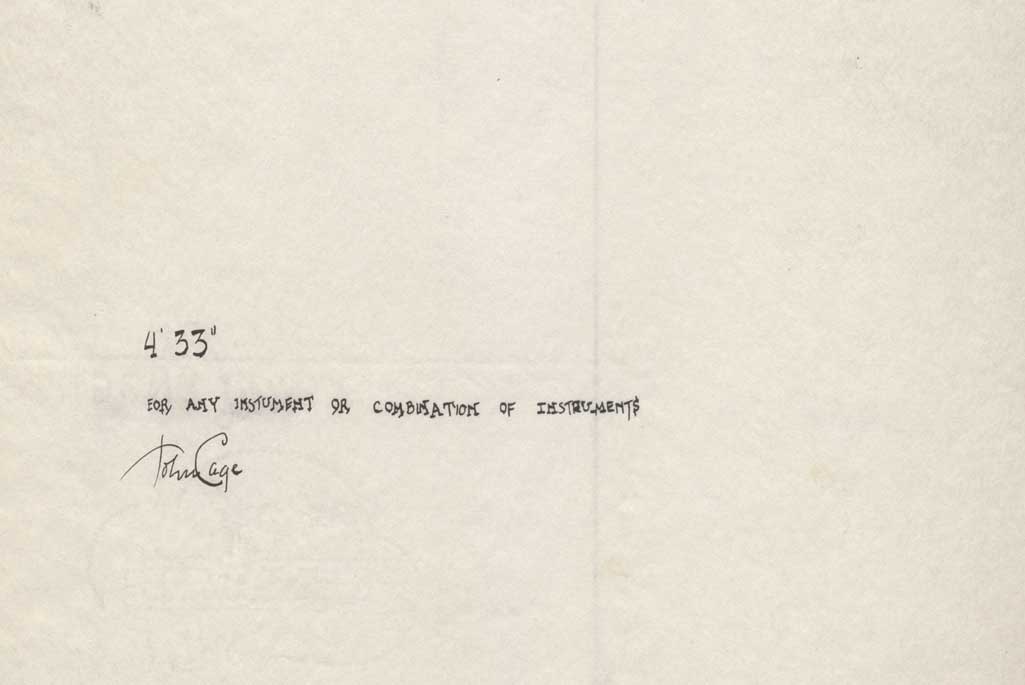In ‘There will be no silence: Scoring John Cage’s 4’33”’, MoMA celebrates its recent acquisition of the score of Cage’s 1952 experimental composition with an exhibition devoted to the piece and its far-reaching impact. Focusing on Cage’s attention to the role of chance and collectivity in artistic creation, the show situates Cage’s work in a narrative of artistic influence that leads inexorably to the ‘death of the artist’, and yet at the same time reminds us just how important artists are.
Cage’s score, on display in the centre of one of the exhibition rooms, is the literal and figurative axis around which the show’s narrative unfolds. Marcel Duchamp’s oft-shown Three Standard Stoppages augurs Cage’s interest in chance. Rauschenberg, whose work purportedly gave Cage the ‘courage’ to explore silence, is represented in the directions for his White Paintings and other smaller works. Cage’s influence over those who came after him is manifested through a number of minimal and conceptual works and, most notably, Fluxus objects. Chief among the latter are a large number of ‘score cards,’ which continue Cage’s deconstruction of the musical form by turning it into a set of directions to be used in performances outside of the realm of music.
While the show is an impressive display of MoMA’s collections (from which most of the objects are taken), it is most notable not for the works included but for the theoretical issues it raises, beginning with the score itself. On some level, it is easy to see why Cage’s scores should be displayed. The silence of 4’33” and the unexpected sounds of Cage’s percussive symphonies test the limits of traditional musical forms, and part of the way those boundaries are tested is through the aesthetics of the score.
Only a very basic understanding of musical notation and a glance at his scores are required in order to grasp the ways that his compositions upend musical conventions. Still, given that this kind of museum exaltation of the art object is more or less incompatible with the artistic ethos that the show attributes to Cage, the display of his score feels incongruous (that having been said, there will be performances of 4’33” as part of the exhibition’s run).
Installation view of the exhibition © 2013 The Museum of Modern Art, New York. Photograph: Jonathan Muzikar

The contradiction of a ‘revolutionary’ work being interred under museum glass is even more starkly apparent in the case of the Fluxus artists who followed Cage. These artists espoused the death of the artist, dissolution of traditional forms, democratisation of art, audience participation, and the creative forces of chance even more vehemently than did Cage. As unsettling as it is to contemplate Cage’s score rather than listen to its performance, it is even more so to examine the cue cards for the Fluxus ‘Happenings’ reified in their perfect white frames in MoMA’s hallowed halls.
Fluxus events presaged an art that had nothing to do with conventional aesthetic experience, but reconvened here they are a forlorn reminder of the fact that this kind of post-modern art cannot cast off all the old trappings of art without effectively ceasing to exist all together. Granting this art of ‘chance’ and collective creativity the significance to be preserved so that future viewers can participate in it requires, at least in our current corporate, market-driven art world, a measure of acquiescence in the old systems against which it defined itself.
Installation view of the exhibition © 2013 The Museum of Modern Art, New York. Photograph: Jonathan Muzikar

With their subversive energy effectively neutered by the museum space, the Fluxus works – and others – give rise to a host of other, more nihilistic reflections on the value of such post-modern art movements all together. The artist is a problematically commercialised figure, yes, but what kind of art can we make if everyone, and no one, is the artist, and none of it adheres to traditional forms?
In a utopian fantasy, it might be some of the most beautiful, moving, and democratically accessible art ever created. Yet in our dystopian reality, that art might simply look like the drudgery of our everyday lives, precisely that which art should allow us to gain a little purchase on, if not transcend. A world without artists, in which any gesture is ‘art’, might actually be a world without art, without its challenges and comforts. Is this a world we would want to live in? The artist is dead. Long live the artist!
‘There Will Never Be Silence: Scoring John Cage’s 4’33″’ is at the Museum of Modern Art (MoMA), New York, until 22 June 2014.




